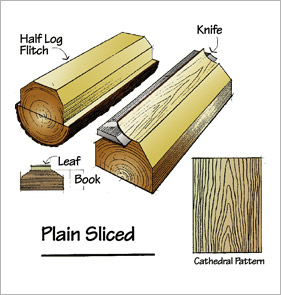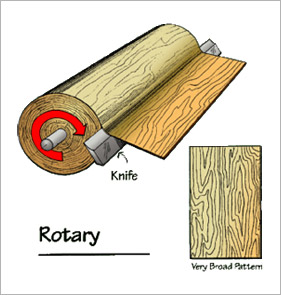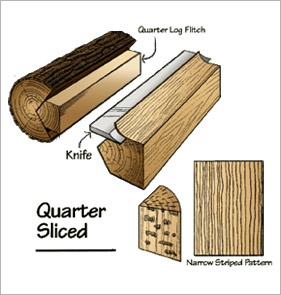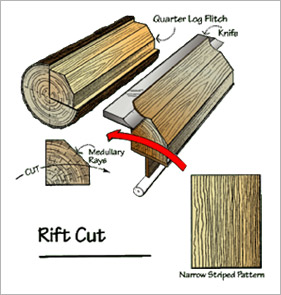| Plain SlicingPlain slicing is the most common veneer cutting method used for high-end decorative and architectural panels, with an appearance similar to that of plain sawn lumber. Typically, leaves are sliced from a half log flitch in parallel to the center cut, creating a natural figure progression with each successive leaf. This natural evolution of grain presentation is well-suited for various matching techniques. Plain sliced veneers exibit a cathedral or flame pattern in the center of the leaf, which begins to straighten as it approaches the lateral edges. |  |
| Rotary CuttingRotary cutting is the most economical veneer slicing method, in which the entire log is mounted on a lathe, and turned against a stationary knife. This essentially peels the log into a single, contiguous sheet. Provided that the width of the resultant sheet is sufficient, this method can be used to produce single-piece faces, covering an entire panel without seams. Rotary cut veneers exibit a wide, erratic grain pattern, making joint matching difficult. A variation of rotary cutting called half round slicing instead uses a half log flitch, and produces veneers with both rotary cut, and plain sliced characteristics. |  |
| Quarter SlicingQuarter slicing involves cutting leaves from a quarter log flitch by orienting the knife perpendicularly to the log’s annual growth rings. This method yeilds relatively narrow sheets in comparison to plain slicing, thus requiring that the source logs be of adequate diameter to create sufficiently wide veneers. The consistent vertical grain pattern acheived by quarter slicing allows the leaves to be easily matched with one another. Some species cut in this way (particularly red and white oak) present a light to heavy flake pattern resulting from bisection of the log’s medullary rays, depending on their prominence. |  |
| Rift CuttingRift cutting is most commonly used on oak species when a vertical grain appearance is desired without the flake effect caused by medullary ray exposure from quarter slicing. This is done by mounting a quarter log flitch onto a lathe, and turning it against a knife whose angle is adjusted to minimize flaking. Due to the involved rotary motion, rift cutting has the ability to produce wider sheets than quarter slicing, making it a desireable method for cutting other species requiring a tight, vertical grain appearance, and wider leaves. As with quarter sliced material, rift cut veneers are easily matched. |  |
Plywood Furniture Hardware Flooring Inspection Sourcing Wood Baseld Panels Furniture Hardware Tools Sauna Kitchen Cabinets Wardrobes
Breaking News
- According to the random inspection results of the quality supervision of wood-based panel products in February 2023, a batch of wood-based panel products produced or sold by one Shandong plywood wood company. were unqualified, and the unqualified items were transverse static bending strength and dip stripping.
- FLOORING CONSTRUCTION,INSPECTION CHECKLIST,TESTING,QUALITY CONTROL REPORT
- FLOORING TEXTURES,INSPECTION CHECKLIST,TESTING,QUALITY CONTROL REPORT
- Herringbone Wood Flooring Inspection Checklist,Testing,QC Report
- Herringbone Flooring Inspection Checklist,Testing,QC Report
- Herringbone Flooring Inspection,Testing,QC Report

